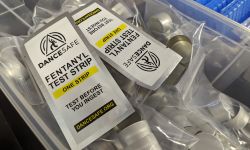Amid drug crisis, one Michigan city is using money to help backfill budget

- So far, Farmington Hills has used all its opioid settlement funds to reimburse past expenses
- The Oakland County community is unique among Michigan communities in choosing to backfill its budget
- The state isn’t tracking how municipalities are spending more than $700 million in opioid settlement funds
Farmington Hills has spent every penny of the $120,000 it has received from opioid lawsuit settlements — and none of it is going to help curb the crisis.
The suburban Oakland County community has used the funds, meant to remediate an epidemic that kills a Michigander every four hours, to backfill its budget for past costs associated with addiction.
That’s something not being done in 118 other Michigan counties, cities and townships for which Bridge Michigan was able to chronicle how opioid settlement dollars are being spent.
Related:
- Michigan communities sit on $90M meant to help drug users, Bridge finds
- How is your Michigan community spending opioid settlement money? Look it up
- How does Michigan use its opioid dollars? Here’s how Bridge found out
- Michigan’s newest weapon in addiction fight runs on gas and four wheels
- Frustration, accusations in tense meeting about Michigan opioid funds
- Opinion | Tackle Michigan's opioid crisis with careful planning, not quick spending
- Read Bridge's exhaustive coverage this year about opioids abuse and spending
Farmington Hills City Manager Gary Mekjian wrote in an email to Bridge that the funds can be used to reimburse past drug-fighting costs.
But critics say that the decision flaunts the intent of the settlement, which was intended to help current users or fight drugs now.
“The easiest thing to do at the end of the day is just dump it in the general fund,” said Jonathan Stoltman, of the Grand Rapids-based Opioid Policy Institute.
“But that’s not what the money is for.”
The spending in this community of 83,000 was one of the surprising findings in a three-month investigation by Bridge Michigan that is the most comprehensive accounting to date of the $156 million that has flowed so far into the bank accounts of the state’s counties, townships and cities. That money is their share of national settlements against manufacturers, distributors and pharmacies accused of fueling the nation’s opioid crisis.
How those dollars are spent has been a mystery until now, because the state does not track opioid settlement spending by local governments.
Advocates say that wise use of these unparalleled resources is critical to curbing an epidemic that kills nearly 3,000 Michigan residents per year, more than car crashes and guns combined.
Local communities will eventually receive at least $745 million over 18 years, close to half of the $1.6 billion flowing into the state as a whole, with the rest distributed by state government.
While 43% of communities had yet to spend any of their opioid funding, the vast majority of those that have opened their checkbooks have invested in local services for prevention, treatment and recovery.
In an emailed response to questions about settlement spending, Mekjian said Farmington Hills has “no specific budget for opioid-related expenditures…. The funds received to-date helped to offset a portion of the prior costs incurred by the city related to the opioid crisis.”
Mekjian said Farmington Hills has $1.3 million in past expenses connected to opioids.
He declined to tell Bridge how the city came up with that figure, saying only that the costs “included personnel time, equipment, Narcan and other supplies.”
From 2019 through mid 2022, Farmington Hills Police had one overdose call every 11 days, according to media reports. In 2021, there were three overdose deaths.
That year, the city launched a “quick response team” that consisted of a police officer and two recovery coaches to visit the homes of those who survived overdoses to offer support.
While other cities formed advisory committees to determine how to spend the money, Farmington Hills officials made the decision by speaking with police, fire and city council members, Mekjian said.
The city manager said the settlement funds are meant to be “retrospective in nature.
But Michigan’s settlement agreement with the drug companies, which is the same for all Michigan communities, states that at least 70% of funds must be used “solely for future opioid remediation.”
That same minimum breakdown of spending is echoed in the state's 2021 agreement with local governments.
Farmington Hills is not yet out of compliance with the agreement. The $119,272.43 the city had used to reimburse city departments as of June 1 represents 12.4% of the $956,709 it will eventually receive over the 18 years of payments.
Farmington Hills could pay itself back as much as $287,000 (30% of its total) in opioid funds before turning its checkbook toward curbing the current crisis. The city will surpass that amount in received settlement funds sometime in 2025, according to opioid settlement payment estimates provided by the state.
One community that has handled its settlement funds differently is Monroe County, where Administrator Michael Bosanac said “we made a conscious decision not to do that and plow our money into treating the problem in front of us.”
“We wanted to make sure we helped the people,” Bosanac said.
Several experts in opioid settlement funds expressed surprise at Farmington Hills’ decisions.
Cara Poland, chair of the Michigan Opioid Advisory Commission, which provides recommendations to the Legislature, acknowledged that “there are allowances for a portion of these dollars to go to past expenses and general expenses,” but that “the spirit of the settlement is to support mitigating the risks currently and in the future.
“I would encourage communities to look for ways to mitigate current and future risks,” Poland said.
The Michigan Municipal League, an association representing the state’s cities, villages and urban townships, has an opioid resources page on its website for its members, where the first link is to a Michigan Association of Counties guidebook that recommends that money be used to “save lives” and “develop a fair and transparent process for deciding where to spend funding.”
Amy Dolinky, technical adviser for opioid settlements for the Michigan Association of Counties, told Bridge that communities should find “ways in which this opportunity can be leveraged to save lives and help those most profoundly impacted by the drug overdose crisis.”
It’s unclear what would happen if communities spend more than 30% of their settlement funds on reimbursement. The Michigan Attorney General’s office has the authority to investigate misuse, but because communities do not report funding to the state, there is no formal mechanism for that office to discover a community is misspending funds.
After publication, a spokesperson for the attorney general’s office responded to Bridge’s request for comment and said the department has not received any complaints about local government spending,
“We would greatly appreciate receiving any information about potential misuse of opioid settlement funds,” said spokesperson Danny Wimmer. “As the enforcement unit designated by the settlements, the Department of Attorney General takes very seriously the appropriate use of these much-needed funds.
“Whether bringing a local government into compliance requires litigation or an accounting remedy, we will work to ensure opioid settlement dollars are spent in a manner consistent with the settlement terms in order to help combat this devastating crisis in Michigan.”
One group of providers and advocates, led by the Grand Rapids-based Opioid Policy Institute, recently demanded more transparency in the way opioid settlement funds are spent in Michigan.
That transparency, the group wrote, “is essential to efficient, accountable, and ethical government spending.”
In an August letter, the group asked the Michigan Department of Treasury to establish “transparent and accountable mechanisms for opioid settlement fund management.”
The letter asks for rulemaking — a technical move that would trigger the development of an audit process for the spending, tracking state and local settlement spending. Efforts to mitigate the drug crisis “comes paired with an obligation to be forthright about the way it is spending settlement funds,” the letter reads.
“The people of Michigan – who have borne the brunt of this crisis – require transparency and accountability to ensure these hard-won settlement funds directly address the epidemic's impact on our communities.”
That would be a good step forward, said Kristen Pendergrass, vice president of state policy at Shatterproof, a Connecticut-based national nonprofit focused on addiction issues. Though reporting and transparency from local governments is not required now, the agreement between the state and municipalities could be changed.
“Transparency in how funds are spent and how decisions are made allows people who have been impacted by the opioid crisis to see how funds are being spent and to weigh in if they disagree with spending decisions,” Pendergrass said.
Get help
For help with opioid abuse, call the SAMSHA National Hotline, a 24-hour, 365-day-a-year, treatment referral hotline. 1-800-662-HELP (4357)
See what new members are saying about why they donated to Bridge Michigan:
- “In order for this information to be accurate and unbiased it must be underwritten by its readers, not by special interests.” - Larry S.
- “Not many other media sources report on the topics Bridge does.” - Susan B.
- “Your journalism is outstanding and rare these days.” - Mark S.
If you want to ensure the future of nonpartisan, nonprofit Michigan journalism, please become a member today. You, too, will be asked why you donated and maybe we'll feature your quote next time!








